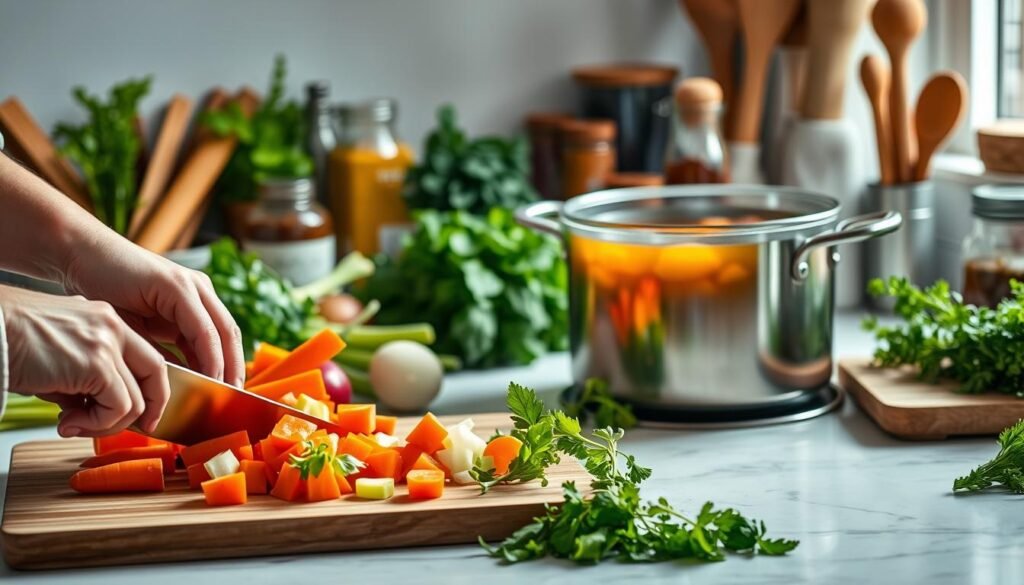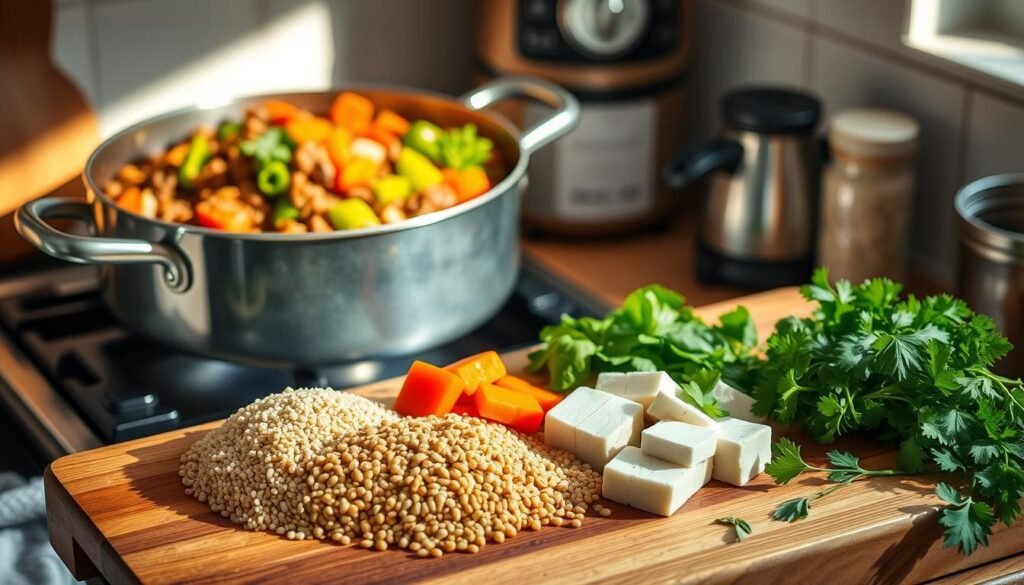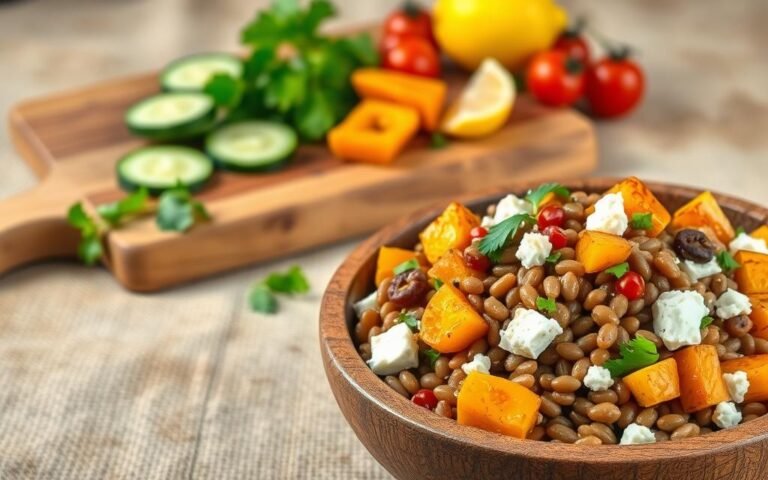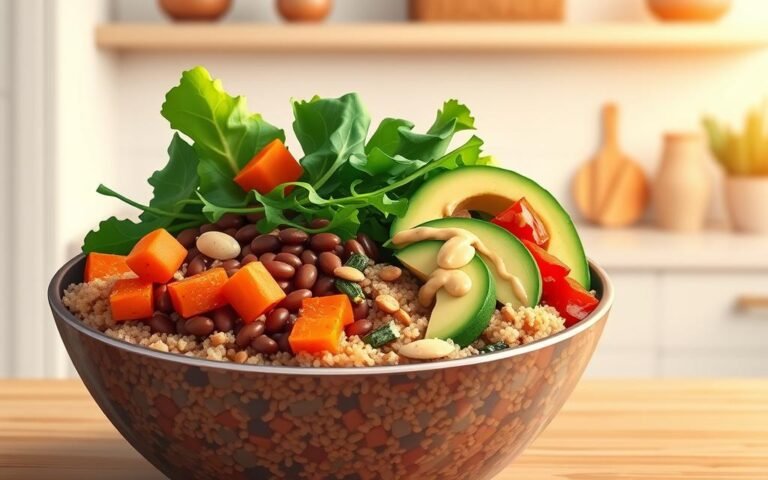As the weather cools down, a warm and comforting bowl of hearty stew is just what you need. This nutritious Lentil Beef Stew is a perfect meal for a chilly evening, serving 8 people and taking around 1 hour 30 minutes to 2 hours 25 minutes to prepare.
This healthy stew is packed with protein-rich beef and lentils, making it a great option for a family dinner or a gathering with friends. The best part is that it’s easy to make and requires minimal supervision, allowing you to enjoy the company of your loved ones while it cooks.
Key Takeaways
- A hearty and nutritious meal perfect for chilly evenings
- Serves 8 people, ideal for family dinners or gatherings
- Preparation time ranges from 1 hour 30 minutes to 2 hours 25 minutes
- Packed with protein-rich beef and lentils
- Easy to make with minimal supervision required
The Rich History of Beef and Lentil Stew
The history of beef and lentil stew is a rich tapestry woven from ancient culinary traditions. This hearty dish has its roots in various cultures, where lentils and meat were combined to create nourishing meals.
Origins of Combining Lentils and Meat
The practice of cooking lentils with meat dates back to ancient times. Lentils were a staple ingredient due to their nutritional value and versatility.
Ancient Culinary Traditions
In ancient civilizations, lentils were valued for their protein content. They were often cooked with meat to create filling meals. This tradition was seen in various cultures, from the Mediterranean to the Indian subcontinent.
Evolution Through Centuries
As trade and migration occurred, the recipe for lentil and beef stew evolved. New ingredients and cooking techniques were incorporated, enriching the dish. By the Middle Ages, variations of this stew were found across Europe and the Middle East.
Cultural Significance Across Different Cuisines
The beef and lentil stew has played a significant role in various cuisines, adapting to local tastes and ingredients.
European Influences
In Europe, the stew was often made with locally available meats and vegetables. The French, for example, added their own twist with herbs like thyme and rosemary.
Middle Eastern Variations
In the Middle East, spices such as cumin and coriander were added to the stew, giving it a distinct flavor. The dish became a staple in many households.
| Region | Common Ingredients | Cooking Method |
|---|---|---|
| Europe | Beef, lentils, thyme, rosemary | Slow cooking |
| Middle East | Beef, lentils, cumin, coriander | Slow cooking with spices |
| Mediterranean | Lentils, vegetables, olive oil | Simmering |
Health Benefits of This Hearty Combination
The Lentil Beef Stew is not only a hearty meal but also a powerhouse of nutrition. This dish combines the nutritional benefits of lentils and beef, making it a wholesome choice for a meal.
Nutritional Profile of Lentils
Lentils are a key ingredient in this stew, providing a rich source of fiber and protein. They are also packed with essential vitamins and minerals that contribute to overall health.
Fiber and Protein Content
Lentils are renowned for their high fiber and protein content, making them an excellent choice for vegetarians and meat-eaters alike. The fiber in lentils helps in maintaining a healthy digestive system, while the protein supports muscle growth and repair.
Essential Vitamins and Minerals
Lentils are a good source of iron, folate, and potassium. These minerals are crucial for maintaining healthy red blood cells, preventing anemia, and supporting overall bodily functions.
Protein and Iron Benefits from Beef
Beef adds significant nutritional value to the stew, particularly in terms of protein and iron. The combination of beef with lentils enhances the overall nutritional profile of the dish.
Complete Protein Advantages
Beef is a complete protein source, meaning it contains all the essential amino acids necessary for the body. When combined with lentils, it provides a meal that is high in protein quality.
Iron Absorption Enhancement
The iron in beef is more easily absorbed by the body when consumed with vitamin C-rich foods. This stew can be paired with a side of vitamin C-rich vegetables to enhance iron absorption. For more information on healthy stew recipes, you can visit The Real Food Dietitians.
Essential Ingredients for the Perfect Recipe Lentil Beef Stew Recipe
The secret to a delicious Lentil Beef Stew Recipe is in the quality and choice of its ingredients. A well-crafted stew requires a thoughtful selection of lentils, beef, and vegetables to create a harmonious balance of flavors and textures.
Selecting the Right Lentils
Lentils are the backbone of this stew, providing protein, fiber, and a rich, earthy flavor. The type of lentil used can significantly impact the dish.
Brown vs. Green vs. Red Lentils
Brown lentils hold their shape well during cooking, making them ideal for stews. Green lentils have a slightly peppery flavor and are also suitable. Red lentils, while delicious, tend to become mushy and are better used in soups or purees.
Australian Lentil Varieties
Australia produces a variety of lentils, including brown and green lentils. Choosing a locally sourced variety can enhance the flavor and support local farmers.
Choosing Quality Beef Cuts
The beef in this stew should be tender and flavorful. The cut of beef used can make a significant difference.
Chuck vs. Round vs. Brisket
Chuck is a popular choice due to its rich flavor and tender texture when slow-cooked. Round is leaner but can become tender with slow cooking. Brisket is another flavorful option that becomes tender with low and slow cooking.
Australian Beef Standards
Look for beef that meets Australian beef standards, ensuring quality and safety. Choosing grass-fed beef can add depth to the stew’s flavor.
Vegetables and Aromatics
Vegetables and aromatics add depth and complexity to the stew.
Essential Base Vegetables
Onions, carrots, and celery form the base of the stew, providing a fundamental flavor profile.
Flavor-Enhancing Herbs
Herbs like thyme and rosemary enhance the flavor, adding a fragrant and savory note to the stew.
Kitchen Equipment You’ll Need
Preparing a hearty lentil stew requires more than just ingredients; it demands the right equipment. To achieve the perfect slow-cooked lentils and tender beef, you’ll need to have the appropriate kitchen tools.
Pot Options: Dutch Oven vs. Slow Cooker
When it comes to cooking your beef and lentil stew, you have two primary options: a Dutch oven or a slow cooker. Both have their advantages.
Heat Distribution Considerations
A Dutch oven is praised for its even heat distribution, which is crucial for cooking lentils and beef evenly. This characteristic helps in preventing hotspots that can lead to undercooked or overcooked areas.
Size and Capacity Guidelines
When choosing between a Dutch oven and a slow cooker, consider the size of your stew. A larger Dutch oven or slow cooker is ideal for big batches, while smaller ones are perfect for fewer servings.
| Equipment | Capacity | Heat Distribution |
|---|---|---|
| Dutch Oven | 3-5 quarts | Excellent |
| Slow Cooker | 4-6 quarts | Good |
Essential Utensils and Tools
Apart from the cooking vessel, you’ll need various utensils to prepare your stew. These include cutting and chopping implements, measuring cups, and stirring equipment.
Cutting and Chopping Implements
A sharp chef’s knife and a sturdy cutting board are indispensable for chopping vegetables and trimming beef.
Measuring and Stirring Equipment
Accurate measurements are crucial, so have measuring cups and spoons on hand. A large spoon or spatula is necessary for stirring the stew.
Preparation Steps Before Cooking
Before diving into the cooking process, it’s essential to prepare your ingredients properly to ensure a flavorful and hearty lentil beef stew.
Properly Cleaning and Soaking Lentils
Cleaning and soaking lentils is a crucial step that enhances their cooking quality and digestibility. Lentils can harbor debris or stones, which need to be removed.
Removing Debris and Stones
Spread the lentils on a flat surface and manually pick out any visible stones or debris. Rinse them under cold running water.
Soaking Times for Different Lentil Types
Green and brown lentils typically require soaking for about 30 minutes to an hour. Red lentils, being softer, may only need 15-20 minutes. Soaking times can vary based on the lentil variety and personal preference.
| Lentil Type | Soaking Time |
|---|---|
| Green/Brown Lentils | 30-60 minutes |
| Red Lentils | 15-20 minutes |
Preparing the Beef and Vegetables
Preparing the beef and vegetables involves cutting and sometimes marinating them to enhance flavor and ensure even cooking.
Cutting Techniques for Even Cooking
Cut the beef into bite-sized pieces, ensuring they’re uniform so that they cook evenly. Vegetables should be chopped according to their cooking time.
Marinating Options for Enhanced Flavor
Marinating the beef in a mixture of olive oil, garlic, and herbs can significantly enhance the stew’s flavor. A minimum of 30 minutes is recommended for marinating.

Step-by-Step Cooking Instructions
Cooking the perfect lentil beef stew requires attention to detail and a step-by-step approach. This ensures that the flavors meld together beautifully and the beef is tender.
Browning the Beef Properly
The first step in cooking our stew is browning the beef. This process enhances the flavor and texture of the meat.
Temperature and Timing Considerations
Heat a tablespoon of oil in a large pot over medium-high heat. Add the beef in batches to avoid overcrowding, and cook until browned on all sides, about 5 minutes per batch.
Achieving the Perfect Sear
Ensure the beef is browned properly by not stirring it too much. A good sear on the beef adds depth to the stew.
Building Flavor with Aromatics
After browning the beef, it’s time to sauté the aromatics. This step is crucial for building the stew’s flavor profile.
Sautéing Onions and Garlic
Reduce the heat to medium and add another tablespoon of oil if necessary. Sauté the onions and garlic until they are softened and fragrant, about 5 minutes.
Incorporating Tomato Paste and Wine
Add a couple of tablespoons of tomato paste and cook for a minute, stirring constantly. Then, add a cup of red wine, scraping the bottom of the pot to release the browned bits.
Adding Lentils and Liquid
With the aromatics and beef browned, it’s time to add the lentils and liquid.
Liquid-to-Lentil Ratio
Use a ratio of 4 cups of liquid (broth or water) for every cup of lentils. This ensures the lentils cook properly without becoming too mushy.
Cooking Time Adjustments
Cooking time may vary depending on the type of lentils used. Green or brown lentils typically take about 30-40 minutes to cook, while red lentils cook faster, around 20-25 minutes.
| Cooking Method | Cooking Time | Lentil Type |
|---|---|---|
| Stovetop | 30-40 minutes | Green/Brown Lentils |
| Slow Cooker | 6-8 hours | Green/Brown Lentils |
| Stovetop | 20-25 minutes | Red Lentils |
Slow Cooking Techniques for Tender Results
The key to a deliciously tender lentil beef stew lies in the slow cooking method you choose. Different techniques can significantly impact the final texture and flavor of your stew.
Stovetop Method
Cooking your lentil beef stew on the stovetop allows for quick adjustments to seasoning and heat. To achieve tender results, it’s crucial to manage the heat and stirring frequency.
Heat Management Tips
Maintaining a low simmer is essential. High heat can cause the lentils to become tough, while too low heat may result in undercooked beef.
Stirring Frequency Guidelines
Stir the stew occasionally to prevent sticking, but avoid over-stirring, which can break the lentils and make the stew mushy.
Oven Method
The oven provides a consistent heat that can evenly cook your lentil beef stew. Understanding the right temperature and cooking vessel is key.
Temperature Settings
A low oven temperature (around 300°F) is ideal for slow cooking. This gentle heat helps to tenderize the beef and cook the lentils perfectly.
Covered vs. Uncovered Cooking
Cooking the stew covered retains moisture, while uncovering it can help thicken the stew. Adjusting the lid can help you achieve your desired consistency.
Slow Cooker Method
Using a slow cooker is one of the most convenient methods, allowing you to cook the stew over several hours without constant supervision.
Timing for Different Settings
On the low setting, cook for 8-10 hours, and on high, 4-6 hours. Adjust based on your slow cooker model and personal preference.
Adapting the Recipe for Slow Cookers
Browning the beef and sautéing aromatics before slow cooking can enhance the flavor. Then, transfer everything to the slow cooker to finish cooking.
By mastering these slow cooking techniques, you can ensure your lentil beef stew turns out tender and flavorful, making it a healthy stew that’s perfect for any meal.
Seasoning Your Stew to Perfection
Seasoning is the key to elevating your recipe lentil beef stew recipe from good to great. The right blend of herbs and spices can transform a simple stew into a culinary masterpiece. In this section, we’ll explore the essential seasonings and techniques to bring out the best flavors in your beef and lentil stew.
Essential Herbs and Spices
The choice of herbs and spices can significantly impact the flavor profile of your stew. Traditional ingredients like thyme, rosemary, and bay leaves are staples for a reason, providing a depth of flavor that’s hard to beat.
Traditional Flavor Combinations
Classic combinations such as thyme and rosemary or bay leaves and black pepper are timeless for a reason. They add a layer of complexity that enhances the overall taste of your beef and lentil stew.
Australian Native Spices to Consider
For a unique twist, consider incorporating Australian native spices like lemon myrtle or Tasmanian pepperberry. These ingredients can add an exciting dimension to your recipe lentil beef stew recipe, making it stand out.
When to Add Seasonings
The timing of when you add seasonings can greatly affect the final flavor. Understanding whether to add herbs and spices early or late in the cooking process is crucial.
Early vs. Late Additions
Some seasonings, like bay leaves, benefit from being added early to allow their flavors to meld with the stew. In contrast, delicate herbs like parsley are best added towards the end to preserve their freshness.
Layering Flavors Throughout Cooking
The art of layering flavors involves adding seasonings at different stages of cooking. This technique ensures a rich, well-rounded taste in your finished beef and lentil stew.
Australian Twist on the Traditional Recipe
The traditional Lentil Beef Stew recipe gets a refreshing makeover with Australian ingredients and wine pairings. By embracing the country’s rich culinary diversity, we can create a dish that’s both familiar and innovative.
Local Ingredients That Enhance Flavor
Australia’s native herbs and locally sourced vegetables can significantly enhance the flavor profile of our Lentil Beef Stew. Incorporating these ingredients not only adds a unique twist but also supports local farmers and producers.
Native Australian Herbs
Native Australian herbs like lemon myrtle and Tasmanian mountain pepper can add a distinct flavor to the stew. These herbs are not only aromatic but also bring a freshness that complements the richness of the beef and lentils.
Locally Sourced Vegetables
Using locally sourced vegetables such as carrots, potatoes, and onions can enhance the stew’s flavor and texture. These ingredients are readily available in most Australian supermarkets and farmers’ markets.
Australian Wine Pairings
A good wine pairing can elevate the dining experience. For our Australian Lentil Beef Stew, a red wine is an ideal match.
Red Wine Recommendations
A robust Australian Shiraz or Cabernet Sauvignon pairs well with the hearty flavors of the stew. These wines are full-bodied and can stand up to the rich flavors of the beef and lentils.
Using Wine in the Cooking Process
Incorporating red wine into the stew during the cooking process can add depth and complexity to the dish. It enhances the beef’s flavor and contributes to a richer sauce.
Variations of the Classic Lentil Beef Stew
Lentil beef stew is a canvas waiting for your creative touch. By modifying the ingredients and techniques, you can create a variety of dishes that cater to different tastes and cuisines.
Mediterranean Version
The Mediterranean version of lentil beef stew incorporates ingredients commonly found in the region, such as olives, tomatoes, and herbs.
Olive and Tomato Additions
Adding olives and sun-dried tomatoes gives the stew a salty, savory flavor. These ingredients are rich in antioxidants and add depth to the dish.
Mediterranean Herb Profile
Using herbs like oregano, thyme, and rosemary creates a herbaceous and aromatic flavor profile, characteristic of Mediterranean cuisine.
Spicy Indian-Inspired Adaptation
For those who enjoy spicy food, an Indian-inspired lentil beef stew can be made by incorporating curry spices and coconut milk.
Curry Spice Blend
A blend of curry powder, cumin, and coriander adds a warm, spicy flavor to the stew. Adjust the level of heat to your liking by adding more or less chili powder.
Coconut Milk Enhancement
Adding coconut milk enriches the stew with a creamy texture and helps to balance the spiciness. It’s a great way to add richness without using heavy cream.
Mushroom Substitutions for Beef
For a vegetarian or vegan version, you can substitute beef with mushrooms, particularly meaty ones like portobello or cremini.
Umami-Boosting Ingredients
Mushrooms are a great source of umami flavor. Enhance this by adding other umami-rich ingredients like miso paste or soy sauce.
These variations demonstrate the flexibility of the classic lentil beef stew recipe, allowing you to experiment with different flavors and ingredients to suit your taste preferences.
Troubleshooting Common Stew Problems
Several issues might arise when preparing your lentil beef stew recipe. Common problems include undercooked lentils, an imbalanced flavor, or an undesirable consistency. This section will help you troubleshoot these issues to achieve a perfect stew.
Fixing Undercooked Lentils
Undercooked lentils can be a disappointment. Fortunately, there are a couple of methods to rectify this issue.
Adding Cooking Time Safely
If your lentils are undercooked, you can continue to simmer them. Check for doneness every 10 minutes to avoid overcooking.
Pressure Cooker Rescue Methods
For a quicker solution, transfer the stew to a pressure cooker. Cooking on high pressure for 10-15 minutes can significantly reduce undercooked lentils.
Remedying a Thin or Thick Stew
The consistency of your stew is crucial. Here’s how to adjust it.
Thickening Agents and Techniques
To thicken your stew, you can use a slurry of cornstarch and water or simply mash some of the cooked lentils to create a thicker consistency.
Thinning Methods Without Losing Flavor
If your stew is too thick, you can thin it out with a bit of broth or water, adding it gradually to achieve the desired consistency.
Balancing Flavors If Something’s Off
Sometimes, the flavor might not be quite right. Here’s how to balance it.
Acid and Salt Adjustments
Adding a splash of vinegar or adjusting the salt level can make a significant difference. Taste and adjust as needed.
Sweetness and Umami Corrections
If the stew lacks depth, a bit of sugar or some umami-rich ingredients like tomato paste can enhance the overall flavor.
Serving Suggestions for Your Hearty Stew
Elevate your beef and lentil stew with complementary side dishes and creative garnishes. A well-rounded meal not only satisfies hunger but also delights the palate.
Complementary Side Dishes
Choosing the right side dishes can enhance the flavors of your beef and lentil stew. Consider pairing it with:
Bread and Grain Pairings
A crusty loaf of bread or a side of warm, fluffy rice can complement the hearty stew. Whole grain bread is a nutritious option that adds fiber to your meal.
Fresh Salad Accompaniments
A fresh green salad with a light vinaigrette dressing provides a refreshing contrast to the rich stew. Include seasonal vegetables to add variety and nutrients.
Garnishing for Presentation
Garnishing your stew not only adds visual appeal but can also enhance the flavor. Consider these ideas:
Herb and Citrus Finishes
A sprinkle of fresh herbs like parsley or thyme, along with a squeeze of lemon juice, can brighten the flavors of your stew.
Creamy Toppings
A dollop of sour cream or a sprinkle of grated cheese can add a creamy texture and rich flavor to your healthy stew.
| Side Dish | Description | Nutritional Benefit |
|---|---|---|
| Crusty Bread | Warm, crusty loaf perfect for dipping | Carbohydrates for energy |
| Green Salad | Fresh mix of greens with seasonal vegetables | Rich in vitamins and antioxidants |
| Sour Cream | Creamy topping for added richness | Additional calories for energy |
Storing and Reheating Tips
To enjoy your Lentil Beef Stew at its best, even on subsequent days, it’s essential to follow the right storage and reheating techniques. This ensures that the flavors remain rich and the texture stays appealing.
Refrigeration Guidelines
When storing your stew in the refrigerator, there are a couple of key considerations to keep in mind.
Proper Cooling Techniques
Before refrigerating, allow the stew to cool down to room temperature to prevent bacterial growth. This can be facilitated by using an ice bath or by stirring in a few ice cubes.
Container Recommendations
Use airtight, shallow containers to store the stew. This not only helps in cooling the stew quickly but also prevents the growth of bacteria. For an added layer of safety, consider using glass containers with tight-fitting lids.
Freezing for Future Meals
Freezing is an excellent way to extend the shelf life of your Lentil Beef Stew. Here are some tips to make the most of it.
Portioning Strategies
Divide the stew into portions that are suitable for a single meal. This makes it easier to thaw and reheat only what you need. You can use freezer-safe bags or containers for this purpose.
Defrosting and Reheating Methods
When you’re ready to eat the stew, thaw it overnight in the refrigerator. Reheat it on the stovetop or in the microwave, ensuring it reaches a minimum of 165°F (74°C) to ensure food safety. For a more detailed guide on reheating, you can refer to our vegan lentil stew recipe page.
| Storage Method | Duration | Reheating Tip |
|---|---|---|
| Refrigeration | 3-4 days | Reheat on stovetop or microwave |
| Freezing | 3-4 months | Thaw overnight, reheat thoroughly |
Making This Stew Budget-Friendly
You can enjoy a nutritious beef and lentil stew on a budget with a few simple tweaks. The key lies in making cost-effective ingredient choices and adopting batch cooking strategies.
Cost-Effective Ingredient Substitutions
One of the simplest ways to make your stew more budget-friendly is by selecting affordable ingredients without compromising on quality.
Economical Beef Cuts
Opting for tougher, cheaper cuts of beef like chuck or brisket can be just as flavorful when slow-cooked. These cuts are not only more affordable but also become tender with the right cooking method.
Seasonal Vegetable Choices
Using seasonal vegetables can significantly reduce costs. Vegetables like carrots and potatoes are not only affordable but also complement the stew well. Check local markets for the best seasonal produce.
Batch Cooking Economics
Batch cooking is another effective strategy for making your stew budget-friendly. It involves cooking large quantities that can be consumed over several meals.
Bulk Purchasing Benefits
Buying ingredients in bulk, such as lentils and spices, can lead to significant savings over time. This approach also reduces packaging waste.
Meal Planning with Leftovers
Planning meals around leftovers ensures that you use every bit of your stew. Consider reheating it for lunches or freezing portions for future meals.
| Ingredient | Cost-Effective Option | Savings |
|---|---|---|
| Beef | Chuck or Brisket | Up to 30% cheaper |
| Vegetables | Seasonal Produce | Up to 20% cheaper |
| Lentils | Bulk Purchase | Up to 40% cheaper |
Health Adaptations for Dietary Needs
Whether you’re watching your sodium intake or managing gluten sensitivity, this stew can be adapted. The recipe lentil beef stew recipe is versatile and can be modified to suit various dietary requirements, making it a healthy stew option for everyone.
Lower Sodium Version
Reducing sodium in the stew can be achieved by using low-sodium broth and limiting added salt.
Herb-Forward Flavor Building
Enhance flavor with herbs like thyme and rosemary, which add depth without salt.
Salt Alternatives
Use potassium chloride or salt-free seasoning blends as alternatives to traditional salt.
Gluten-Free Considerations
Ensure the stew is gluten-free by checking the ingredients of the broth and any added spices.
Hidden Gluten Sources to Avoid
Be mindful of gluten in some broths or spice mixes, opting for certified gluten-free products.
Thickening Without Flour
Use cornstarch or arrowroot powder to thicken the stew instead of flour.
Lower Calorie Modifications
To reduce calories, consider using leaner cuts of beef and increasing the vegetable-to-meat ratio.
Leaner Beef Options
Choose lean beef cuts like sirloin or round to lower the fat content.
Vegetable-to-Meat Ratio Adjustments
Adding more vegetables not only reduces calories but also increases fiber and nutrients.
| Dietary Need | Adaptation | Benefit |
|---|---|---|
| Lower Sodium | Use low-sodium broth and herbs for flavor | Reduces blood pressure risk |
| Gluten-Free | Use gluten-free broth and thickening agents | Makes stew safe for gluten intolerance |
| Lower Calorie | Increase vegetables and use lean beef | Reduces overall calorie intake |

Conclusion: Why This Lentil Beef Stew Deserves a Place in Your Recipe Collection
The beef and lentil stew is a nutritious and comforting meal option that has captured the hearts of many. With its rich history, numerous health benefits, and versatility, it’s no wonder this dish is a staple in many cuisines around the world, including Australia.
By incorporating slow cooked lentils and quality beef cuts, this healthy stew provides a boost of protein, fiber, and essential nutrients. The recipe’s adaptability to various dietary needs and preferences makes it an excellent addition to any meal plan.
Whether you’re looking for a comforting meal on a chilly evening or a nutritious option for a family dinner, the recipe lentil beef stew recipe is sure to satisfy. Its ease of preparation and flexibility in cooking methods, including slow cooking, make it a convenient choice for busy home cooks.
Incorporating this stew into your recipe collection will not only provide a delicious and healthy stew option but also a dish that can be enjoyed by the whole family. So, take the first step in making this hearty stew a part of your culinary repertoire.





